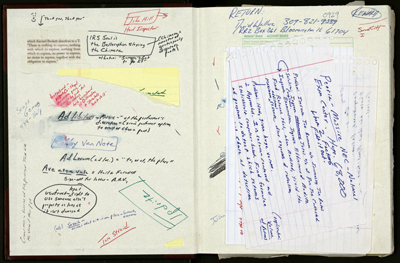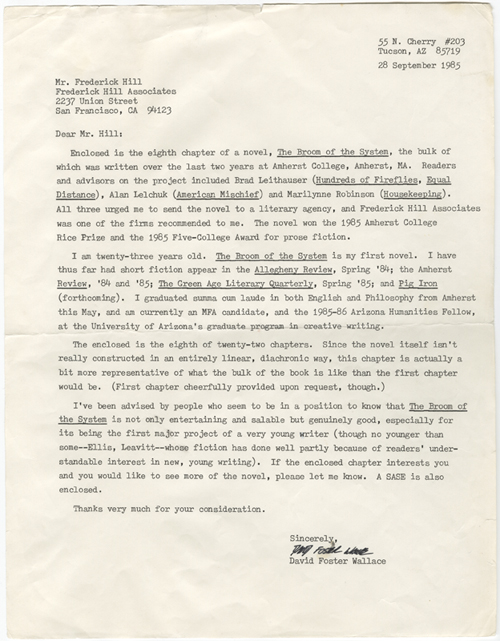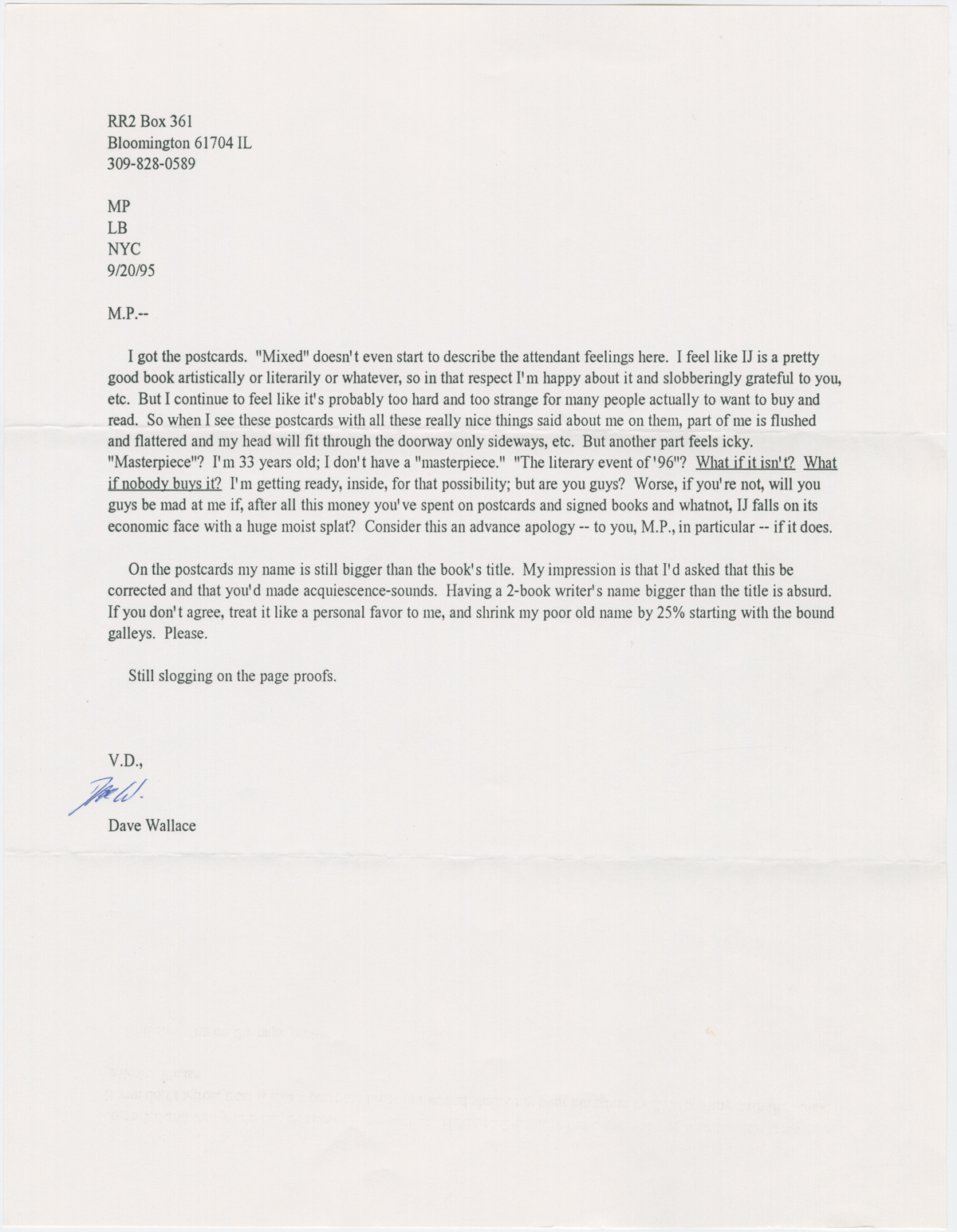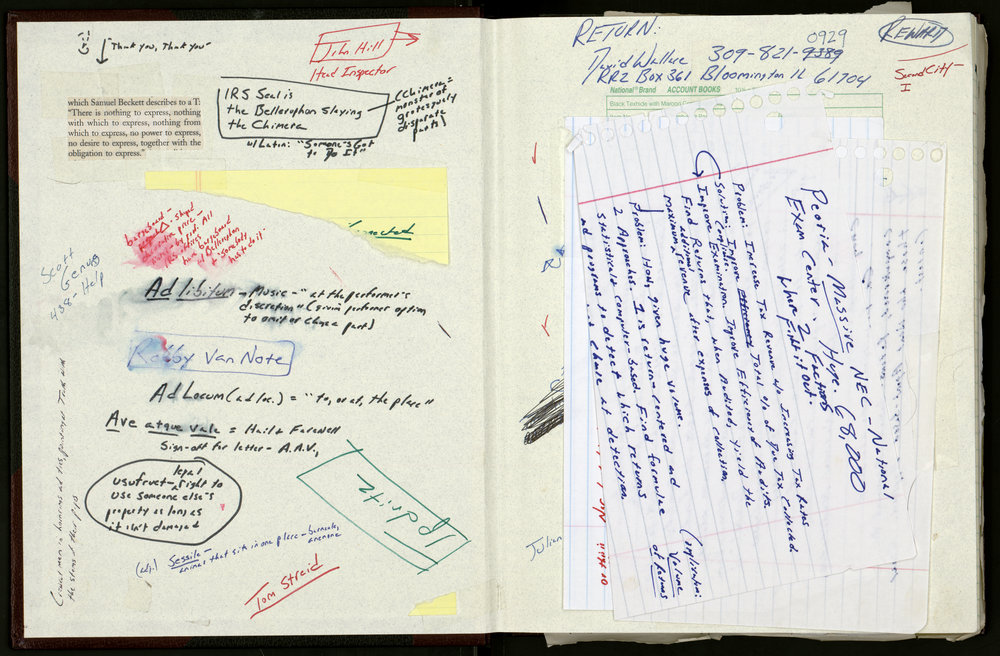Twenty years ago, in February of 1996, Little, Brown and Company published David Foster Wallace’s (1962–2008) novel Infinite Jest. It was a bold undertaking for the firm to publish a complex, challenging novel that spans over 1,000 pages and contains hundreds of endnotes, many quite lengthy and all printed in very small type. The sheer size of the book required that it be sold for $30, an unorthodox price for any novel, let alone a second novel by a young, up-and-coming author. [Read more…] about David Foster Wallace and 20 years of Infinite Jest
Michael Pietsch
David Foster Wallace materials related to "The Pale King now open for research"
Materials related to David Foster Wallace’s posthumous novel The Pale King (April 2011) are now open for research at the Ransom Center. The materials related to The Pale King were acquired as part of the Wallace (1962–2008) archive in 2010 but were retained by publisher Little, Brown and Co. until after the book’s publication and the subsequent publication of the paperback edition.
The Pale King materials fill six boxes and include handwritten and typescript drafts, outlines, characters lists, research materials, and a set of notebooks containing reading notes, names, snippets of dialog, definitions, quotations, and clippings.
The materials have been organized according to a spreadsheet developed by Wallace’s editor, Michael Pietsch. Pietsch, then-executive vice president and publisher of Little, Brown and Co., spent months reading through and organizing the material and found what he called “an astonishingly full novel, created with the superabundant originality and humor that were uniquely David’s.”
In conjunction with the publication of The Pale King, the Ransom Center partnered with publisher Little, Brown and Co. to offer an online preview of materials from the archive in April 2011.

New David Foster Wallace materials to be on display during Wallace Symposium

On Thursday, April 5, the Ransom Center kicks off The David Foster Wallace Symposium with a public event featuring Wallace’s literary agent, Bonnie Nadell, and his editor, Michael Pietsch, in conversation with Los Angeles Times book critic David Ulin. The free, public event will take place at 7 p.m. (C.S.T.) at Jessen Auditorium, across the plaza from the Ransom Center on The University of Texas at Austin campus. Please note that seating will be limited. Registrants of the symposium will have reserved seating, and Ransom Center members will receive priority entry at 6:20 p.m. Doors will open to the general public at 6:30 p.m.
Throughout the day on Friday, April 6, the symposium will continue with a series of panel discussions featuring esteemed writers, editors, critics, and journalists who will consider Wallace’s work, his life, and his contribution to contemporary literature. Registration is limited, and only a few spaces remain.
The Ransom Center acquired the David Foster Wallace papers and Wallace’s personal library in late 2009. Since that time, the Center has acquired several smaller collections related to Wallace, including:
- The Bonnie Nadell collection of David Foster Wallace, spanning nearly 30 years and documenting Nadell’s representation of Wallace as his literary agent through personal and professional correspondence.
- Photocopies of Wallace’s completed “usage ballots” for the American Heritage Dictionary. Wallace was a member of the company’s board that governs decisions on usage, spelling, and pronunciation.
- Items related to “Democracy and Commerce at the U. S. Open,” an article Wallace wrote for Tennis magazine in 1995, including correspondence with Jay Jennings, senior editor at Tennis.
- A photocopy of a typed letter from Wallace to Brandon Hobson in which Wallace gives writing advice to the then-22-year-old Hobson.
- Nine annotated drafts of “Host,” an essay Wallace published in The Atlantic Monthly in 2005, together with correspondence related to the essay between Wallace and Martha Spaulding of The Atlantic.
- A small collection of correspondence, primarily from Wallace to recipients including collector Bernard Peyton Watson, who donated the materials.
- An unpublished typescript essay titled Pearls & Swine by Wallace, written at the request of James Harmon, who wrote to well-known individuals requesting that they respond to the question, “If you could offer the young people of today one piece of advice, what would it be?”
- A collection of correspondence and manuscripts Wallace sent to editor and literary critic Steven Moore between 1987 and 2004, together with photocopies of correspondence from Wallace to writer David Markson.
A two-case display of select items from these various collections will be on view in the Ransom Center’s lobby April 3–8.
Because of anticipated high demand for the use of the Wallace papers and associated collections during the symposium, all researchers intending to request access to these materials must inform curatorial staff of their research plans in advance of their visit, no later than March 30, 2012. To protect the materials, space and access will be limited. Walk-ins will not have access to the materials during this time.
We look forward to welcoming symposium participants, registrants, and other guests to the Ransom Center during the symposium to celebrate the life and work of one of the most creative and influential writers of our time.

